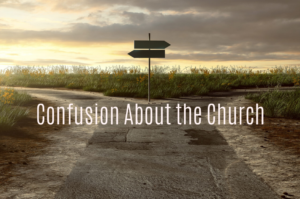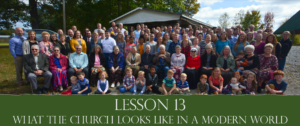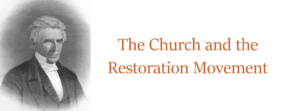The Church and the Restoration Movement Pt. 1 ended with the question: “What teaching and practice did the leaders of this movement abandon?” These men, Alexander Campbell, Barton W. Stone, Walter Scott, and others, began slowly to separate from the existing denominations (i.e.- Presbyterian, Methodist, Baptist, etc.) concluding that all man-made denominations had departed from the original church pattern in one or more teachings/practices. If a church practice could not be found in scripture, it was aptly termed “unscriptural.” And if a given church was unwilling to correct this practice in conformity to scripture, the undesirable yet necessary conclusion was to separate from that church. Eventually, these men separated themselves from all man made denominations and took on the simple name given to Christians in the New Testament “disciples.” This transition did not take place overnight. Rather, the Restoration Movement spanned the 100 year period that was the 1800’s, and this spirit of restorationism continues into the 21st century today.
Unscriptural Teaching
There were many denominational teachings that were marked as unscriptural, but here we will review just a few.
1. Calvinism
Barton W. Stone did not agree with the Methodist teaching commonly termed Calvinism. Calvinism is a five-part doctrine teaching that 1) man is born a sinner, depraved and condemned from birth, 2) man must have this sinful nature supernaturally transformed by the irresistible force of the Holy Spirit, 3) God has predetermined who He will transform and who He will not, 4) Jesus’ blood was only shed for those whom God predetermined to be saved, and 5) those transformed by God’s grace cannot and will not lose their salvation. You can listen to an examination of this five-part doctrine in our Five Minute Bible Study Sermon Series entitled Introducing Calvinism (Click Here). Stone simultaneously was dismissed and resigned himself from the Methodist Episcopal Church for claiming that, “Calvinism is among the heaviest clogs on Christianity…discouraging…sinners from seeking the kingdom of God,” (The Churching of America).
2. Baptism
Baptism eventually became the principle teaching and practice that distinguished these preachers of the Restoration Movement from their denominational counterparts. This distinction was two fold. First, the likes of A. Campbell came to the conclusion that infant baptism (a byproduct of Calvinism) was not only unnecessary but altogether unscriptural. Campbell initially disassociated himself from the Presbyterian churches because of this discovery. He taught, using scripture as his burden of proof, that baptism was only for those who could intelligently believe and obey the command to be immersed in water. Second, Campbell eventually concluded that baptism was for the express purpose of remitting sins or washing sins away (Acts 2:38; 22:16). Campbell’s early stance against infant baptism brought him into the good graces of the Baptist churches in his area; however, as Campbell pursued the scriptural teaching that baptism was the point in time when a sinner becomes a Christian, having his sins washed away, he soon found himself at odds with the Baptist association as well. As Campbell, Stone, Scott, and others began preaching that baptism was for understanding adults and for the remission of sins, droves of people came forward to be baptized, and literally hundreds began leaving man made denominations to be joined with the disciples.
Tolbert Fanning
In 1831 a young preacher by the name of Tolbert Fanning began preaching in Tennessee and Alabama. He would eventually travel with and learn from A. Campbell, but in 1831 he did something that very well captured the spirit of the Restoration Movement regarding false teaching and practice. James Wilburn describes the event like this- “Once, he had gone to preach…and he found a warm camp meeting in progress where he was scheduled to participate. There was straw on the ground around the ‘mourner’s bench.’ During a recess and before the time for Fanning to speak, he secured some help and gathered up the straw and accessories to the mourner’s bench and carried them off to throw them down a nearby hill… Fanning sat silently while the zealous members condemned the dastardly deed. When his turn to preach arrived, he delivered a sermon on the evils of the mourner’s bench system, and the church there never used the method again.” For anyone naive to the ‘mourner’s bench’ system, it was the practice of preachers calling sinners to a bench at the front of an assembly where they could pray and ask Jesus into their heart. Fanning discovered this practice to be foreign to scripture and outright misleading. Some might question his tactics, but the results of his determination and preaching speak for themselves.
Unscriptural Practice
There were many other practices that disciples found unscriptural and began to discuss publicly as they made attempt at restoring the New Testament church pattern. Issues such as the one-man-pastor system, church government by councils and associations, the existence of church creeds to determine faith and practice, parachurch organizations such as missionary societies, and many others became hotly contested items during the 1800’s and extending into the 1900’s.
Conclusion
The disciples of the Restoration Movement eventually took on the name Church of Christ. The Church of Christ is widespread across the United States today, though mostly including the Midwestern and Eastern states. In the 1900’s there were several churches which became disassociated with those that still go by the name Church of Christ. Their differences center mainly on issues such as how to interpret scripture, the use of instrumental music in worship, individual cups and loaves in the Lord’s Supper, the use of church funds, and the existence of church organizations larger than the local church. If you have further questions regarding the Church of Christ, what it teaches, and what it practices, feel free to contact me via the Subscribe & Contact page or the Five Minute Bible Study Facebook Page.
Coming Soon- What the Church Looks Like In a Modern World
References: 1) The Hazard of the Die by James Wilburn 2) Attitudes and Consequences by Homer Hailey



Comments
My great grandfather was a preacher who was part of the Restoration Movement in the Church of Christ who preached at churches all over North America until the church got a permanent preacher then he moved on to the next church that needed him. I have a list of churches until 1915. His brother was also a part of that movement but in a different copacity.
Author
That’s really cool. What was his name?